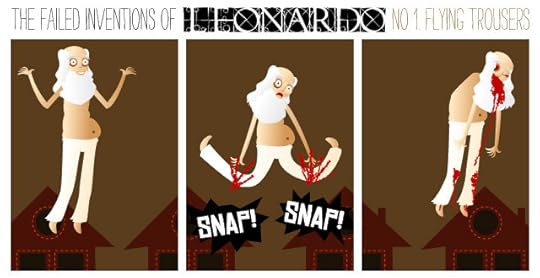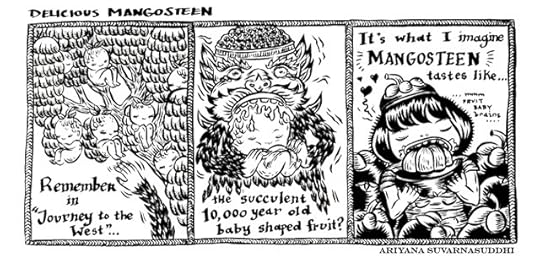Warren Ellis's Blog, page 98
September 13, 2011
THREE PANELS OPEN: Esquivel Godlewski Cody Barajas

Script: Eric M. Esquivel (www.Facebook.com/ericMesquivelFanPage)
Art: Scott Godlewski (http://scottgodlewski.com/)
Colors: Ryan Cody (http://super75comics.wordpress.com/)
Letters: Henry Barajas (http://henrybarajas.wordpress.com/)
September 12, 2011
THREE PANELS OPEN: Rónán O'Broin
THREE PANELS OPEN: Ariyana Suvarnasuddhi
THREE PANELS OPEN: Dean Trippe
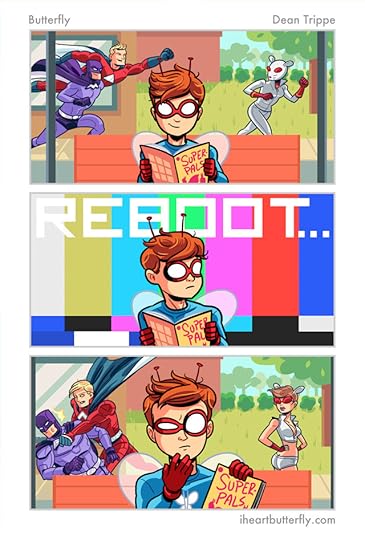
Dean Trippe
Related articles
GUEST INFORMANT: Lauren Beukes (warrenellis.com)
Planet Pulp (warrenellis.com)

September 9, 2011
Night Music: talkingmakesnosense
Dominic Dixon's ambient drone work is exactly what I need right now. Click through to buy the album for four quid. G'night.
Coruscates by talkingmakesnosense
Related articles
Balam Acab: "Expect" and "Oh, Why" (warrenellis.com)
British Summer Time (warrenellis.com)
GUEST INFORMANT: Colleen Nika & EHF (warrenellis.com)

September 8, 2011
GUEST INFORMANT: Lauren Beukes
Lauren Beukes is a journalist, tv writer and author of the award-winning sf novel ZOO CITY. She's also recently moved into comics writing (I took great pleasure, a few weeks ago, in introducing her to the fine people at Isotope Comics in San Francisco, who essentially threw her a "welcome to comics" party.) I asked her if she'd have time to crank out a little something, and she produced the following epic for you:
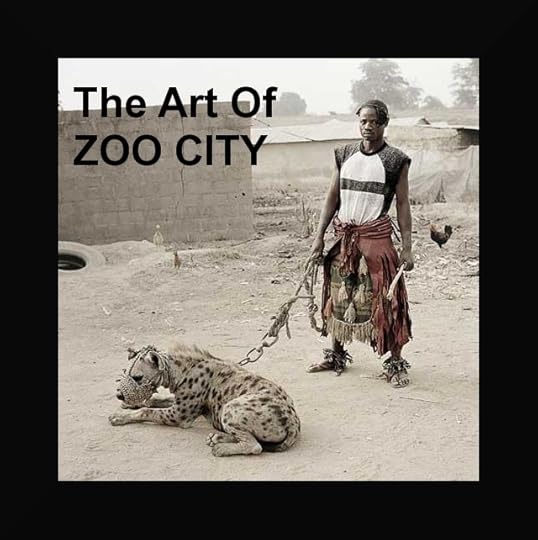
"It's only art, Ms December," she says, not meaning a word of it."
- chapter 13, Zoo City
Art has a habit of sneaking into my fiction in interesting ways (including limited edition art toys).
Sometimes it's bleedingly obvious, like the mental short story I wrote about giant tentacled monsters made from suicides' hair and Takashi Murakami flower balls in "Unathi Battles The Black Hairballs" or the genetically modified bio-art creature, Woof 'n' Tweet that gets a rather violently unfavourable response in Moxyland . (Partly inspired, of course, by Theo Jansen's amazing Strandbeests and audio installations by artists like James Webb)
And sometimes it's more subtle.
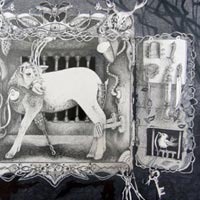 The truth is Zoo City came about because an illustrator friend Simon Villet was commissioned by the notoriously limited edition South African design magazine iJusi to design an "imaginary book cover". He approached me to come up with the wordy bits and I wrote a synopsis for an idea that was already lurking in the back of my head – a phantasmagorical noir about a girl with a sloth on her back who crosses a magician gang-lord in the slums of inner city Johannesburg. (I can't link to the image, alas, because the original title is spoilerific.)
The truth is Zoo City came about because an illustrator friend Simon Villet was commissioned by the notoriously limited edition South African design magazine iJusi to design an "imaginary book cover". He approached me to come up with the wordy bits and I wrote a synopsis for an idea that was already lurking in the back of my head – a phantasmagorical noir about a girl with a sloth on her back who crosses a magician gang-lord in the slums of inner city Johannesburg. (I can't link to the image, alas, because the original title is spoilerific.)
The actual novel does not feature a major art-related scene (unless you count artful email scams). But it does include shout-outs to several real artworks by artists I hugely admire.
Most of it goes down in chapter 13, when fast-talking, Sloth-carrying protagonist Zinzi December visits The Haven on the trail of a missing pop star. The Haven is a rehab centre and clearly doing well enough from their celebrity clients that they can afford some SERIOUS art. And a lot of that art is doing double-time, not just as decorative detail, but in serving the plot with hints and allegations of things to come.

Purely decorative? The Technicolor smiley flowers behind the reception desk, which are, yep, Takashi Murakami (I may have a thing for his work).
 The Devil in repose by Brett Murray and Conrad Botes has a deeper backstory. It was a work I desperately wanted to buy at the original opening about ten years ago, but it was already sold by the time I got there.
The Devil in repose by Brett Murray and Conrad Botes has a deeper backstory. It was a work I desperately wanted to buy at the original opening about ten years ago, but it was already sold by the time I got there.
I would only find out who bought it several years later when I was on assignment for Cosmopolitan magazine, doing an investigative story on rehab safaris.
Turns out that The Devil hangs above the fireplace in the communal lounge at the Kenilworth addiction clinic in Cape Town – a black-humoured reminder of temptation, kicking back in his chair, just waiting for you to succumb. It was a wonderful detail. So I appropriated it for the novel.
Working harder to serve the plot is The Scapegoat, a dreamy etching of a buck with its head bowed and a chain around its neck, by Louisa Betteridge. It's there as a way in to a conversation about Zoos and what their magical animals might represent, like the ancient Israelite scapegoat, that was sent in to the wilderness to die carrying the burden of evil.
But the art is also there to prompt a line of dialogue about accountability: "penetrating people's denial systems, removing the alibis that will trip them up." My hero, former addict, email scammer and finder of lost things, Zinzi December has a lot of alibis.
There's also a Colbert Mashile* original, hanging above the director of the Haven's desk. Mashile is an artist I first discovered at the University of Kwa-Zulu Natal gallery in Durban and again didn't manage to buy back when his art was still affordable. The painting described (this one is thematically similar) is one of his early works: a grass hut ablaze, a deep phallic root, figures writhing in torment – from his circumcision series, that is described in the novel as being about "culture and tradition, rites of passage, the difficulties of being a man. And also being mutilated".
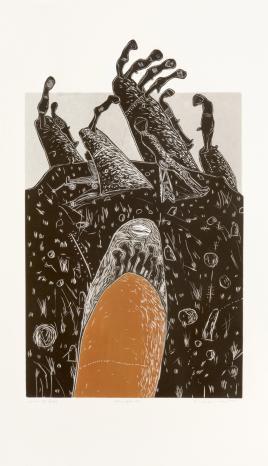 Zinzi doesn't know it yet, but it's a foreshadowing of mutilations to come in the story ahead. But the description of the painting also foreshadows deep roots – and rot – speaking to subterranean pain and the secret things that lie beneath the surface.
Zinzi doesn't know it yet, but it's a foreshadowing of mutilations to come in the story ahead. But the description of the painting also foreshadows deep roots – and rot – speaking to subterranean pain and the secret things that lie beneath the surface.
There's another work that's not mentioned, except in the acknowledgements, but many readers have picked up on. "The Hyena and Other Men" is a series of photographs by my friend Pieter Hugo that left an indelible impression on me. You're probably already familiar with the pictures – they've been published in magazines and newspapers and exhibited all over the planet.
According to Pieter, the subjects are an informal travelling circus troupe who also work as debt collectors. Because there's nothing like a hyena in your home to encourage you to cough up your outstanding loan. According to Pieter, the handlers steal the cubs from dens when they're still little and feed them a steady dose of hash to keep them docile.
The image stayed with me and was definitely one of the seedlings in my brain that germinated into Zoo City . I referenced it with the novel's fictional gangsta rapper Slinger who poses with a snarling Hyena in his music videos, two years before Beyonce appropriated the image for hers, for reals.
I like art. I like using it in my writing, name-checking the artists I admire or the works that have affected me, making them a part of the texture of the story. But I realise I can only try to make words as powerful and provocative and profound as those images. And that make me feel jealous and inadequate, but also really grateful that it's out there.
(*If it reads "Mandla Langa" in your copy of Zoo City, congratulations, you got the collector's first print-run edition with the egregious error on my part! I was reading Colours of the Chameleon at the time, used the name automatically and managed to slip it past me and my editor.)
Lauren is on Twitter. You can learn more about ZOO CITY here, a book I recommend.
Related articles
GUEST INFORMANT: Colleen Nika & EHF (warrenellis.com)
GUEST INFORMANT: Jan Chipchase (warrenellis.com)
GUEST INFORMANT: Matthew Sheret (warrenellis.com)
GUEST INFORMANT: Colleen Nika (warrenellis.com)
GUEST INFORMANT: Jess Nevins (warrenellis.com)
GUEST INFORMANT: Richard J. Lockley-Hobson (warrenellis.com)

GUEST INFORMANT: Richard J. Lockley-Hobson
Richard J. Lockley-Hobson of the Hauntological Society asked me to write something for them. I had to point out that I am not very clever, and in fact it would be a much better thing if he wrote something for you. So he did:
"I confess I do not believe in time. I like to fold my magic carpet, after use, in such a way as to superimpose one part of the pattern upon another. Let visitors trip. And the highest enjoyment of timelessness-in a landscape selected at random-is when I stand among rare butterflies and their food plants. This is ecstasy, and behind the ecstasy is something else, which is hard to explain. It is like a momentary vacuum into which rushes all that I love. A sense of oneness with sun and stone. A thrill of gratitude to whom it may concern-to the contrapuntal genius of human fate or to tender ghosts humoring a lucky mortal".
You have just read a section from Vladimir Nabokov's 1966 (revised) autobiography 'Speak, Memory'. It touches on many of the themes that can be considered Hauntological. Hauntology, a word you've no doubt heard before, but as an 'ology' you feel it has yet to coalesce into something you can fully understand.
Lets start at a literal beginning…"To haunt does not mean to be present, and it is necessary to introduce haunting into the very construction of a concept. Of every concept, beginning with the concepts of being and time. That is what we would be calling here a Hauntology. Ontology opposes it only in a movement of exorcism. Ontology is a conjuration". This is a section from Jacques Derrida's 1993 work, Specters of Marx: The State of the Debt, the Work of Mourning & the New International, pg 202. This is the origin of the word, and the idea(s) behind the word.
Suffice to say, since its conception, the word, or term (and the ideas behind it), have taken on a life of their own. Although much maligned by almost every other deconstructionist philosopher, Derrida's Hauntology, now filtered through a hundred other ideas, interlinked and contradictory, has taken root in many different fields.
Considered by some to be a kind of Backward Looking-Forward Thinking/Backward Thinking-Forward Looking philosophy, the term, is more often than not, applied to what could be referred to as unpopular culture; a mix 'n' match of analog electronics, suburban witchcraft, unsettling children's TV, faded visions of the future and the great outdoors – amongst other things. This New Hauntology seems to have little or nothing to do with its namesake, and there appears to be much that can be considered Hauntological.
There will always be a question of interpretation, of application. This so-called zeitgeist is the spirit of all times, the past, and the future, converging in the present. Although it can sometimes seem that this New Hauntology is constantly being trivialised, there will always be a line that leads you back to Derrida, and back further still.
In it's purest form, that which can be considered Hauntological has been with us for a long, long time. Long before Derrida. He has just given us a word. In a 2010 interview, author Alan Garner talks of "a sense of otherness, that goes right back". Garner is of course the author of the 1973 children's book 'The Owl Service'. Itself a much referenced and key work, in Hauntology's post-Derrida world. "Yesterday, today, tomorrow – they don't mean anything. I feel they're here at the same time: waiting. How long have you felt this? I don't know. Since yesterday? I don't know. I don't know what 'yesterday' was. And that's what's frightening you? Not just that, said Alison. All of me's confused the same way. I keep wanting to laugh and cry. Sounds dead metaphysical to me, said Gwyn".
I will refrain from discussing or listing further themes, key words, or phrases, prevalent in Hauntology, new and old, as I'm aware that you are probably still none-the-wiser. Instead I shall hand you over to our friends at The Hauntological Society. Their aim is to curate the sum of Hauntology's parts, from the available information, so as to give you a better understanding, over time.
However, before I go – It is my considered opinion that Hauntology will eventually come together as a Social Science, that will explore this 'otherness' that makes us who we are. Individually and as a group. As an 'ology' it will find its place.


Richard J. Lockley-Hobson likes to keep busy… Here, here & here.
Related articles
GUEST INFORMANT: Matthew Sheret (warrenellis.com)
GUEST INFORMANT: Jan Chipchase (warrenellis.com)
GUEST INFORMANT: Colleen Nika (warrenellis.com)
GUEST INFORMANT: Jess Nevins (warrenellis.com)
GUEST INFORMANT: Colleen Nika & EHF (warrenellis.com)

September 7, 2011
GUEST INFORMANT: Colleen Nika & EHF
Colleen returns to bring you a fantastic mix that she let me listen to a few days ago.
Today, I'm excited to unveil Nightvision's first ever guest mix from one of England's most visionary emergent threats, Endless House Foundation. This audience may particularly appreciate not only its expansive electronic textures, but the transcendent ethos that governed their synthesis here. Dramatic Records' modern-day impresario 'Jack Dramatic' curated this kosmische collage for us on behalf of the wondrous, now-defunct Endless House collective. We adore it and think it provides a suitably cosmic contrast to the jarring blackout sounds of Nightvision's own taster mix, 'Enter The Void // Death Drone 001′, which we posted Monday. With EHF's mix, we offer a second, more celestial portal into the Nightvision world, a hyperrealistic realm that, like Endless House itself, is often populated by incandescently eccentric guests.
In his 45 minute mix, Dramatic combines unusual external resources to transport us through the otherworldly circuitry of Endless House's own kraut-saluting ethos. Though it ostensibly lives inside 2011, we think EH's founder, the Czech svengali Jiri Kantor, and his mythical mid-Cold War electronic gentry — Rasmus Folk, Felix Uran, Walter Schnaffs et al — would feel at ease within the collage's shapeshifting values. Constructs like time and location vanish into irrelevance, as a new frontier, a new solution emerges: the future past. This isn't retro, it's the re-imagining of something that almost was — and could be again.
If these lofty concepts and names sound fantastical and strange to you, they should, but rest assured that you'll come to know what drives Jack Dramatic and his EHF brethren when time collapses during our first ever interview exclusive featuring The Endless House, which shall be our next post. We are clockstoppers here at Nightvision — one of our many other tricks.
For now, enjoy a glorious, nonlinear journey through spacey post-chronological sounds, the way Jack Dramatic (and we) like them. Take note of Omar Souleyman's opening lament, the decades-fracturing Orson Welles broadcasts, the coruscating post-step prose from Egyptrixxx and ambient drone-hymns from Emeralds and Oneohtrix Never, as well as some murkily seductive synth treasures from John Maus and Endless House's own Felix Uran. We find this mix to be well-acclimated for travel (in its various forms).
Nomads that we are, we've played this a lot in the past few weeks. We think you'll be doing the same — today, tomorrow, and when yesterday is today.
Endless House Foundation – NIGHTVISION Mix by Nightvision on Mixcloud
This is Nightvision. This is Dramatic Records on Twitter.
Related articles
GUEST INFORMANT: Colleen Nika (warrenellis.com)
GUEST INFORMANT: Jess Nevins (warrenellis.com)
GUEST INFORMANT: Matthew Sheret (warrenellis.com)
GUEST INFORMANT: Jan Chipchase (warrenellis.com)
For The Comickers: THREE PANELS OPEN (warrenellis.com)

September 6, 2011
GUEST INFORMANT: Jan Chipchase
Jan: "You should have been with me! We had to run from (some horrible foreign urban nightmare) to (some collapsing "airport" that didn't deserve the name) to make the (flight on a converted Sopwith Camel) with minutes to spare and there was (probably gunfire)!"
Me: "…run?"
Jan Chipchase is kind of hard to describe. Basically, he's a strategist/technologist who travels the world with teams of ethnographers and designers, looking at how people use communications devices in different cultures. I like to kid him that he's the Indiana Jones of user experience. He's one of those wonderful people who's essentially invented his own job, and I asked him to write to you about where (roughly) he is today:

The goal is this: to be able to walk into and out of of situation and leave with at least a nugget of information that relates to the research topic of day. It sounds simple enough and mostly is, except that the pressure to perform pretty much anywhere in the world – from London to Lagos, New York to to New Delhi, and sometimes a little off the beaten track. Last week's participants, for a study in Nigeria included amongst many others: families in tight knit slum community mopping up after a deadly flood; a dapper tribal chief talking about mobile phone coverage; and a wee-hours interview with a cop in a country where being stopped by one of the boys in black will result in a shakedown. The interviews also included a reformed human smuggler/trafficker – describing the process/route of taking economic and political refugees from Khartoum, Sudan across the desert and the Mediterranean into southern Europe. Street interactions require a massive bullshit detector and my starting position is one of a skeptic on tall stories but he had a good working knowledge of the Chad/Libyan border crossing and a nuanced recollection of process. I call it as I see it.
The trick on the ground is to be able to read both the persons and the context and to create a situation where interaction with the stranger in their midst is the natural next step. It's like picking someone up in a bar but without the sexual intent. Show respect before, during and after the conversation, leverage non-verbal cues and pay attention to the details. It's not just about reading the street – you need to let the street read you.
One informal research method that you won't find written up in any manual is called the Meanest Motherfucker – seek out the meanest, most unlikely candidate for an interview (whether or not they have an oedipus complex) and open them up to a meaningful conversation. Child's play, if only because mean is subjective, and bound by the limits of our experience of the human condition.
Three things I've learned:
Everyone has a story to tell, most people don't have someone to listen.
Never ask the question if you're not willing to listen to, and act upon the answer.
Avoid drunks with guns.

Today's office is here, give or take.
Jan Chipchase is an Executive Creative Director for Global Insights at Frog Design. He's on Twitter.
Related articles
GUEST INFORMANT: Colleen Nika (warrenellis.com)
GUEST INFORMANT: Matthew Sheret (warrenellis.com)
GUEST INFORMANT: Jess Nevins (warrenellis.com)

GUEST INFORMANT: Jess Nevins
My friend Jess Nevins is a librarian, cultural researcher & scholar, and the author of books like the incredible FANTASTIC VICTORIANA and the famous LEAGUE OF EXTRAORDINARY GENTLEMEN annotation volumes. I asked him to write to you about whatever he was interested in today, and he sent this:

Fandom wasn't always such a negative experience for creators.
I don't mean fans. Creators have had devoted fans since at least Sappho's time. I mean fandom. Which as we all know was the creation of English teenaged girls at the start of the 19th century.
Right?
The "commonplace book" is a kind of scrapbook made up of quotes, excerpts, poems, and so on which has been around in one form or another since the 14th century. But in the early 19th century keeping a commonplace book was seen as a female practice, in much the same way that the novel was seen as a female genre at this time. Assembling a commonplace book was especially popular among young women, who saw them as "patchwork quilts" well-suited for bringing together their favorite poems or lines of poetry.
Some historians of commonplace books see this as an early form of bricolage. But for English teenagers in the early 19th century, art wasn't being created through the assemblage of quotes, a persona was.
Traditionally the commonplace book had been intended for the compiler's eyes only, but by the 19th century the commonplace book was intended to be seen by the friends of the compiler. The usual practice was to pass the book to a friend, who would sign it and add his or her own favorite quotes and poems. Social status was conferred by having a well-known member of the community or poet or artist sign your commonplace book, but for the most part the book was meant as a record of your friends. The commonplace book was no longer about remembering quotes, but about remembering friends, and presenting yourself to them. Your friends would judge you on what was in your commonplace book, what you read and what you wrote. And the farther your commonplace book circulated, the more signatures you received in it and the more worldly your poetic excerpts showed you to be, the higher in social ranking you rose among your friends.
You can see the resemblance to Facebook, can't you?
Fandom arose from the approach commonplace book compilers took to reading: actively, in what theorist Michel de Certeau might have called an act of poaching ("readers are like travelers, they move across lands belonging to someone else, like nomads poaching their way across fields"). In the early 19th century Lord Byron was the most-quoted author, the most referred-to, the one who loomed largest in the collective consciousness of readers. Lord Byron also created a unique dynamic for his readers; they were fans of Byron but were also aware of being part of the community of Byron fandom, a fandom they actively organized and propagated. Byron fans felt they had a unique understanding of him and his work, and expressed this in their choice of excerpts from his works.
Often the poems were copied with a rigorous attention to the original text. But nearly as often, the commonplace compilers would edit the original text, deleting some lines and altering others, so that a love poem to a woman from a man would be changed to a love poem from a woman to a man. Comparisons of the original poems with what appears in commonplace books shows that commonplace compilers often sought out unauthorized versions of the poems, or original manuscripts (rather than the versions appearing in the published "authorized" or "complete" works). Dueling versions of a poem would often appear in a commonplace book, allowing for the compiler and her readers to write their own comments on which version was superior, or to suggest improvements to the poem.
Byron's reaction to these changes was not what might be expected. He had his own commonplace book and actively participated in commonplace culture, happily writing quotes of his own work in his fans' commonplace books and even commenting on their alterations of his own work. He found it an opportunity to flirt, of course–this is Lord Byron, after all, and his "Verses, Written in Compliance with a Lady's Request to Contribute to Her Album" [link] is one long un-subtle pick-up line–but he also encouraged his fans to keep challenging his work. He enjoyed the process of interacting with his fandom through commonplace books, and even put poems in his fans' commonplace books which appeared nowhere else, as was the case with "Verses, Written in Compliance with a Lady's Request to Contribute to Her Album."
Those days are long gone, of course. Byron's fandom was a community of equals, more or less, whose statements and activities were restrained by manners and common courtesy. There were no Secret Masters of Byron Fandom, there was no trolling, and no behavior that made Byron swear off interacting with his fans. Online anonymity has much to recommend it, but it has assured us that something like Byron's relations with his fans will never happen again.
Good job, Internet.
Jess' wonderfully odd Tumblr can be found here, and he's also on Twitter.
Related articles
GUEST INFORMANT: Colleen Nika (warrenellis.com)
GUEST INFORMANT: Matthew Sheret (warrenellis.com)
The No Longer Weekly Katie West (warrenellis.com)

Warren Ellis's Blog
- Warren Ellis's profile
- 5768 followers


